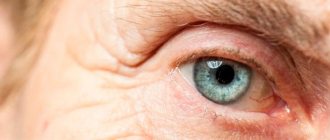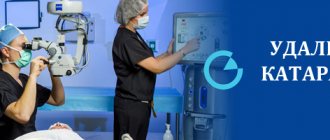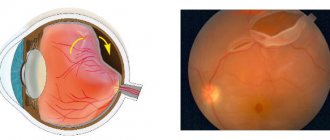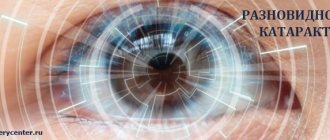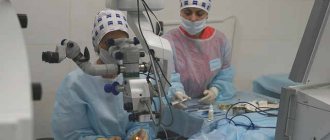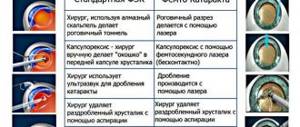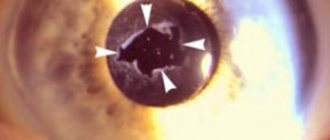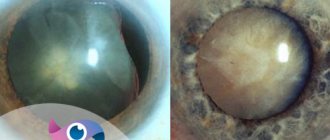Secondary cataract is a complication that can develop after surgery on the lens of the eye. The safest and most effective method of treating cataracts is implantation of an intraocular lens in place of the removed natural lens. During this operation, the lens is removed from the capsule (elastic thin sac) containing it. Modern technologies make it possible to preserve the lens capsule and place an implant in it. However, even the most successful operation does not eliminate the risk of developing secondary cataracts. Successful lens replacement itself may be complicated by clouding and hardening of the posterior wall of its capsule. As a result of cellular and immune reactions to surgical intervention, the epithelium of the capsular bag begins to grow, its tissue loses transparency, transmits less light rays and, as a result, a reactive, secondary weakening of vision develops. This process does not depend on the quality and accuracy of the manipulations performed, but on the individual physiological characteristics of the patient, therefore it is impossible to predict and prevent the development of secondary cataracts.
Indications and contraindications
Laser cataract surgery has certain indications and contraindications. Indications for laser treatment:
- clouding of the lens with decreased visual function;
- people with altered corneas (dystrophic changes, small thickness);
- swollen, overripe forms of cataract;
- cataract in combination with secondary glaucoma;
- secondary turbidity.
Contraindications to laser treatment of cataracts:
- infectious diseases of the eyes or other organs;
- period of exacerbation of chronic diseases;
- disorders of the blood coagulation system;
- uncorrected cardiovascular pathologies;
- presence of a pacemaker;
- diabetes mellitus with unstable glucose levels;
- increased ICP;
- oncological neoplasms.
Laser treatment is not recommended for pregnant women due to changes in hormonal status. The decision to undergo laser treatment for children under 18 years of age is made on an individual basis.
Causes of cataract development
The exact cause leading to clouding of the lens has not been identified to date; ophthalmologists have only a few hypotheses to explain the development of the pathology:
- intense exposure to ultraviolet radiation on the mucous membrane of the eyes;
- age criterion, since cataracts are diagnosed in patients over 70 years of age;
- improperly formulated diet with a minimum amount of antioxidants;
- decreased hemoglobin;
- toxic poisoning;
- eye injury;
- physical exhaustion due to poor nutrition;
- frequent inflammatory eye diseases;
- genetic predisposition.
Preparation for the event
Before laser cataract removal, you need to consult a therapist, cardiologist, dentist, or ENT doctor. The mandatory set of tests includes blood, urine, ECG, and FLG tests.
If the operation is planned for the morning, then the last meal should be the night before no later than 20 hours. If the operation is planned for the afternoon, you can drink sweet tea in the morning.
It is prohibited to drink alcohol the day before the procedure. It is not recommended to smoke on the day of treatment. If you are very nervous, you can drink a herbal sedative or herbal tea at night.
Laser removal
The femtosecond laser has been used for vision correction . Now, the technology is actively used to remove cataracts. Modern equipment allows the operation to be performed practically without the intervention of a surgeon. The specialist controls the process on the screens, directing the laser. No surgical instruments are used, which reduces the risk of poor results and negative consequences.
The operation takes place in several stages:
- Parameters are measured to form microscopic approaches. Since they are created using a non-contact method, regeneration occurs, which eliminates the appearance of astigmatism.
- is formed in the capsular bag for insertion of an artificial lens . The requirements for the procedure are an even round shape and a central location.
- The lens nucleus is pre-fragmented.
The laser focuses inside the lens without damaging the cornea . After a short-term effect, the affected organ is destroyed into small particles.
Laser-assisted surgery is used in severe cases when other methods cannot be used due to other diseases:
- Glaucoma.
- Diabetes.
- Lens subluxation.
- Any types of corneal dystrophy.
- Loss of endothelial cells.
- Various eye injuries.
Main stages
The laser machine is equipped with a computer on which the operation process is simulated. The doctor determines exactly where the corneal incision needs to be made. The built-in tomograph allows you to see the entire working area during laser cataract removal.
Stages of laser treatment:
- The person is placed on the couch.
- Local anesthesia is performed.
- Drops are instilled to dilate the pupil.
- Using a laser beam, surgical access is created on the cornea.
- The lens is crushed using a laser or ultrasound to form an emulsion.
- The destroyed parts of the lens are aspirated, that is, removed.
- Rinse the eye cavity.
- An intraocular lens (IOL) is placed.
- Final treatment is carried out with antiseptic solutions.
No stitches are needed. Cataract surgery takes 10–30 minutes. If everything went well, the person can go home on the same day.
If a person develops repeated opacification after a while, then laser dissection of the secondary cataract is performed. The essence of laser dissection is to create a hole in the back of the lens capsule and remove the cloudy film. For secondary cataracts, laser treatment is considered the safest method for preserving the IOL.
After surgery, follow the rules of the rehabilitation period and do not refuse the prescribed therapy. This will avoid possible complications and speed up the recovery of the eye organ.
Additionally, see the process of removing eye cataracts using a laser:
Equipment for cataract treatment
Our clinic uses the latest equipment designed to radically get rid of cataracts (cataract surgery). In particular, this is the Infiniti phacoemulsifier, which allows you to safely operate on patients who have even the hardest cataracts in advanced cases.
Another phacoemulsifier, Millennium manufactured by Bausch & Lomb (USA), can be used not only for cataract surgery in particularly difficult cases, but also for the treatment of many other diseases and pathologies.
In our clinic, for knifeless cataract surgery (cataract surgery), we use the only registered femtosecond laser in Russia, which performs all the main stages of the operation automatically.
How does phacoemulsification occur?
1. At the beginning, the ophthalmic surgeon or femtosecond laser creates a micro-incision of about 2.5 mm, through which all further manipulations will be carried out
2. A special substance is injected into the anterior chamber of the eye, designed to protect the internal structures of the eye.
3. The cataract-affected lens is destroyed with ultrasound and removed through a vacuum microsyringe
4. A flexible intraocular lens is inserted into the capsule where the affected lens was previously located, which will now serve as a lens
5. After the operation is completed, the substance injected into the eye is washed out using an irrigation solution
Recovery after surgery
Lens replacement for cataracts is painless, without anesthesia. Immediately after the intervention, the patient returns to good vision, and it becomes ideal within a period of 2 days to a week.
This method of cataract removal is the only operation that has been recognized by the World Health Organization as completely rehabilitative.
Prevention of cataracts
Is it possible to prevent cataracts? Cataract is an eye disease accompanied by clouding of the lens caused by natural processes in the body associated with age-related changes.
Prevention is usually called any measures designed to prevent the development of a disease. But cataracts, unfortunately, cannot be prevented. Clouding of the lens, alas, cannot be stopped once the process has begun. In this case, prevention in the literal sense of the word is not effective. In modern medicine today there are no medications that eliminate cataracts. The only possible and safe method of returning full vision is eye surgery.
But you can try to delay the onset of age-related changes in the lens if you regularly follow these tips:
- 1. Don’t smoke and generally lead a healthy lifestyle;
- 2. Protect eyes from sunlight and UV radiation;
- 3. Eat a balanced diet and take enough vitamins.
The purpose of prescribing eye drops for cataracts is to delay the active process of opacification at an early stage of the disease. But the effect of the drops will not overcome the disease itself and their effectiveness has not yet been scientifically proven. In the later stages, it is impossible to defeat cataracts without surgery!
Treatment of cataracts with folk remedies
Is it possible to cure cataracts with folk remedies?
Most elderly people, unfortunately, trust advertising and incompetent advice, and listen to recommendations from unreliable sources. While they waste energy and money searching for miracle drugs and doing useless exercises, precious time is wasted. This is the period when it is not too late to help your vision. But this should be done not by dietary supplements and natural herbs in parallel with acupuncture, but by competent specialists. While performing lotions and rinsing with homemade drops and witchcraft spells for the full moon, the cataract continues to progress. If the operation is not performed on time, then vision can be lost irreversibly due to a serious complication - secondary glaucoma. Ophthalmologists strongly recommend that patients not engage in self-healing for the benefit of their own health.
Cataracts can only be defeated with modern technologies, which are available only in one area of medicine - microsurgery.
Rehabilitation
The postoperative period lasts up to six months. During this time, there is a gradual improvement in vision clarity. After laser cataract extraction, it is necessary to protect the operated organ from adverse effects:
- protect eyes from ultraviolet rays and foreign particles;
- do not use decorative cosmetics (2 weeks);
- avoid getting soap and shampoo into your eyes;
- limit physical activity and heavy lifting (1 month);
- limit time spent on the computer and TV;
- do not visit the bathhouse, sauna, swimming pool (up to 1 month).
For preventive purposes, eye drops are prescribed:
- Antibacterial for the prevention of infection: “Albucid”, “Levomycetin”.
- Moisturizing: Visine, Systane.
- Anti-inflammatory: Indocollir, Diclofenac.
In the first days of the postoperative period, to relieve pain, you can take non-steroidal anti-inflammatory drugs in tablets: Nimesulide, Ibuprofen.
Distinctive characteristic
- Technology . The main difference between laser-assisted surgery and ultrasound phacoemulsification is the main element. The use of laser and ultrasound removes the affected lens from the eye, but this process is implemented in different ways.
- Fracture of the affected organ . The laser beam crushes the clouded lens to the smallest particles, which are then sucked out with a special tip. Ultrasound transforms the lens into a liquid emulsion state. It is removed from the eye through a pipe system.
- Incision . The laser gently moves the eye tissues apart. This results in a smooth hole. To use phacoemulsification, the surgeon makes an incision with a diamond knife. Doctor's intervention can harm eye health. Laser technology is completely safe.
- Doctor's intervention . For ultrasound phacoemulsification, the doctor performs surgical procedures. During laser-assisted surgery, a specialist controls the process using computer equipment and directs the laser along the eye model. No personal contact with the patient is required.
- Entering tools . The ultrasonic tip destroys the diseased lens inside the eye. The laser beam penetrates the cornea without inserting instruments, which increases the safety of the operation and the likelihood of a positive result.
- Thermal impact . When ultrasound is used, the cornea may become warm. When a dense cataract is removed, there is a risk of burning the visual organ. The laser penetrates the structure without heating the cornea. So, the recovery process is faster.
Complications
Failure to comply with the rules for maintaining the rehabilitation period, concomitant pathologies, and violation of the surgical technique can lead to the development of complications:
- IOL displacement;
- protrusion of the cornea;
- retinal disinsertion;
- hemorrhage;
- retinal swelling;
- infectious complications;
- secondary cataract.
If you notice that after surgery your quality of vision has begun to deteriorate, inflammatory signs have appeared (severe redness, swelling, pain, discharge from the eyes), or the shape of the eyeball has changed, then consult a doctor immediately. The sooner the doctor begins proper treatment, the greater the likelihood of avoiding repeated surgery.
Stages of cataract surgery for retinal degeneration
- Local drip anesthesia.
- The surgeon creates a microscopic incision in the cornea to expose the lens.
- Ultrasound grinding of lens masses. The lens is emulsified and removed from the eye.
- An intraocular lens is placed in place of the removed lens: it automatically takes the desired position.
- Antiseptic treatment.
No stitches are required during the operation. If the manipulations are successful, the patient can go home.
The duration of the operation is 15-20 minutes. Subsequently, the patient is observed by an ophthalmologist.
Cost of the operation
The estimated cost of laser surgery for cataracts starts from 40,000 per eye. Pre-collection of tests not included in this amount is required. Laser treatment is carried out on the basis of specialized budget and private clinics.
Laser treatment creates conditions for rapid recovery of the eyeball, which shortens the rehabilitation period. High precision of the laser beam minimizes the risks of complications. Vision begins to recover in the first days after surgery and reaches maximum quality within six months.
Are you familiar with laser treatment for cataracts? Tell us about your impressions in the comments. Share the article on social networks. Protect your eyesight. All the best.
Benefits of cataract removal at the International Vision Center
In our center, operations are carried out by high-class specialists who regularly improve their skills abroad. The clinic is equipped with modern equipment that allows you to undergo a comprehensive examination without leaving the building.
After the operation, the center’s ophthalmologists monitor the patient’s condition and take measures to prevent complications. Within a month after the operation, all examinations are carried out free of charge. By choosing our clinic, you are calm about your health and receive a guarantee of the return of good vision in the absence of serious contraindications.
